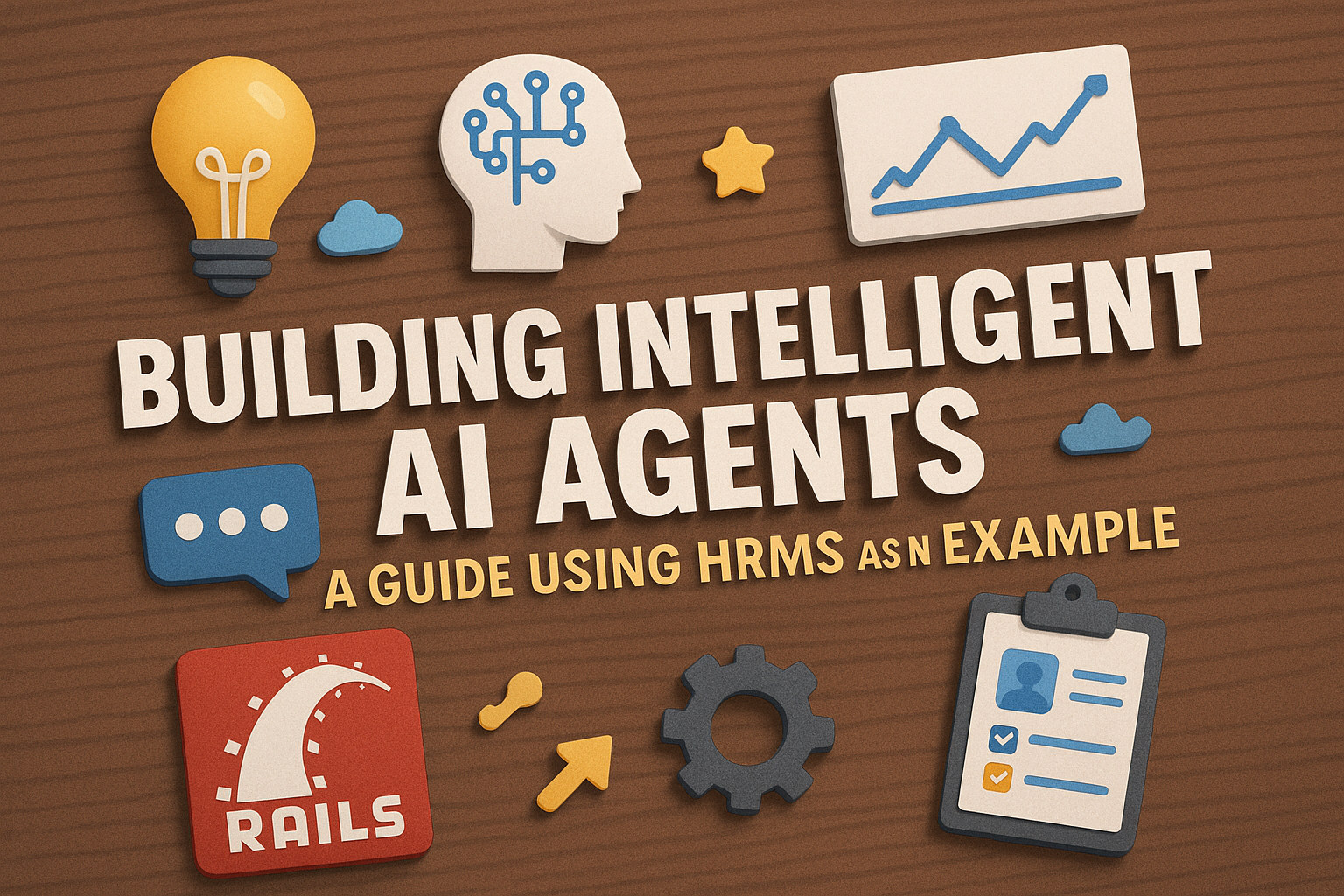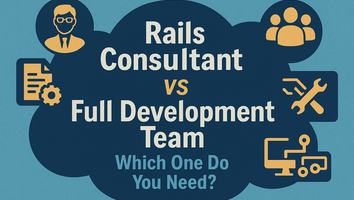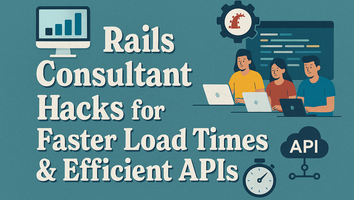Introduction
AI agents are emerging as the next phase of intelligent automation. These autonomous entities understand natural language, reason through tasks, interact with APIs and tools, and execute workflows. Unlike traditional scripts, they handle dynamic instructions and context with impressive flexibility.
For developers working with frameworks like Ruby on Rails, AI agents offer a new frontier for automating internal systems, support platforms, and domain-specific tools. Businesses partnering with a Ruby on Rails consulting company can leverage these advancements to build smarter, scalable, and secure automation systems.
The rise of Ruby on Rails AI solutions has made it easier than ever to integrate LLMs with web applications for intelligent automation. In this blog, we’ll explore how to conceptually design and technically implement AI agents using Rails and large language models (LLMs).
We’ll cover:
- Multi-agent architectures
- ReAct prompting
- Tool integration
- A practical application: Automating a Human Resource Management System (HRMS)
Understanding AI Agents
AI agents are intelligent, autonomous software programs powered by large language models (LLMs). They can:
- Interpret natural language
- Reason through multi-step tasks
- Interact with humans and digital systems
Unlike scripts that follow hardcoded instructions, AI agents adapt dynamically based on intent, data, and prior interactions.
Core Capabilities
- Natural Language Understanding (NLU): Interpreting human language into actionable meaning.
- Reasoning & Planning: Sequencing logical steps for task completion.
- Tool Use: Interacting with APIs, databases, or digital resources.
- Context Retention (Memory): Tracking prior conversations or preferences.
- Autonomous Execution: Acting without constant human intervention.
Example:
A simple script checks an employee’s leave balance. An AI agent, however, can:
- Understand “I’m planning to take a few days off next week.”
- Ask clarifying questions.
- Check leave balance.
- Apply for leave & notify manager.
- Suggest alternatives if balance is insufficient.
A skilled Rails consultant can design and deploy such intelligent systems within existing business frameworks, enhancing productivity and decision-making.
AI Agent Architecture in Practice
Designing reliable, secure, and scalable AI agents requires breaking them into well-defined components.
1. Router (Triage) Agent
Acts like a dispatcher—decides which sub-agent should handle a request.
Flow: Input → Router Agent → LLM → Structured Output
Example JSON output:
# Example JSON { "agent": "hrms", "params": { "task": "apply_leave", "days": 3, "start_date": "2025-08-12" } }
2. Sub-Agents
Each is a domain specialist.
- HRMSAgent: Leave requests, employee profiles, holiday calendars
- FinanceAgent: Expense claims, budgets, invoices
- ITAgent: Hardware/software requests, troubleshooting
Components inside Sub-Agents:
- Prompt templates
- Tool access definitions
- Lifecycle hooks (logging, permissions, enrichment)
3. Tools
The execution layer — they can query databases, call APIs, or generate documents.
Rails Example:
# lib/tools/leave_balance_tool.rb class LeaveBalanceTool def self.check_balance(user) LeaveBalance.find_by(user_id: user.id)&.remaining_days || 0 end end
4. Memory Store
Memory = Continuity.
- Short-term: Redis (conversation history)
- Long-term: PostgreSQL (via AgentMemory model)
class AgentMemory < ApplicationRecord belongs_to :user serialize :history, JSON end
5. Security Layer
Since agents can perform powerful actions, ensure security via:
- JWT authentication
- Role-Based Access Control (RBAC)
- Validated tool inputs
- Action logging for audits
Rails Implementation: Step-by-Step
Step 1: Integrating OpenAI
# Gemfile gem "openai" # config/initializers/openai.rb OpenAI.api_key = ENV.fetch("OPENAI_API_KEY")
Step 2: LLM Wrapper
class LLMClient def initialize(model: "gpt-4", temperature: 0.0) @client = OpenAI::Client.new @model = model @temperature = temperature end def chat(messages, functions: []) @client.chat( parameters: { model: @model, messages: messages, temperature: @temperature, function_call: "auto", functions: functions } ) end end
Step 3: Router Agent Logic
router_prompt = [
{ role: "system", content: "You are a router agent. Return JSON with 'agent' and 'params'." },
{ role: "user", content: "I want 3 days off starting next Monday." }
]
response = LLMClient.new.chat(router_prompt)
parsed = JSON.parse(response.dig("choices", 0, "message", "content"))
Step 4: Tool Example in Rails
class LeaveBalanceTool def self.check_balance(user) LeaveBalance.find_by(user_id: user.id)&.remaining_days || 0 end end
Applying AI Agents to an HRMS Portal
The HRMS Agent can:
- Receive leave requests
- Check balances
- Update HRMS records
- Send notifications
- Answer HR policy questions
Initialization Example
hrms_agent = LlmAgent.new( name: "hrms_agent", model: hrms_agent_model, instruction: HRMS_AGENT_PROMPT.format(current_date: Date.today), description: "Handles queries about employee data, leave, holidays, etc.", tools: [hrms_toolset] )
Security, Memory, and Production Considerations
- Authentication: JWT + Devise
- Memory: Redis (short-term), PostgreSQL (long-term)
- Scaling: Docker + Kubernetes
- Monitoring: Log LLM calls & tool executions
Beyond HRMS: Other Use Cases
- Customer Support Bots: Ticket escalation
- Finance Automation: Invoice/payment tracking
- IT Service Desk: Automated troubleshooting
- Procurement Agents: Supplier communication
Summary
- AI agent concepts & architecture
- Rails implementation steps
- Practical HRMS example
- Broader use cases
This approach enables automation that feels human, adapts dynamically, and integrates deeply with business systems.
Let’s Build Together
At W3villa, we design and deploy production-ready AI agents. As a trusted Ruby on Rails consulting company, we help enterprises harness the full potential of AI and automation.
We can help with:
- Architecting multi-agent systems
- Securely integrating OpenAI with Rails
- Prompt engineering, memory, and routing logic
- Scaling with robust security
Contact W3villa today to start your AI agent journey.



